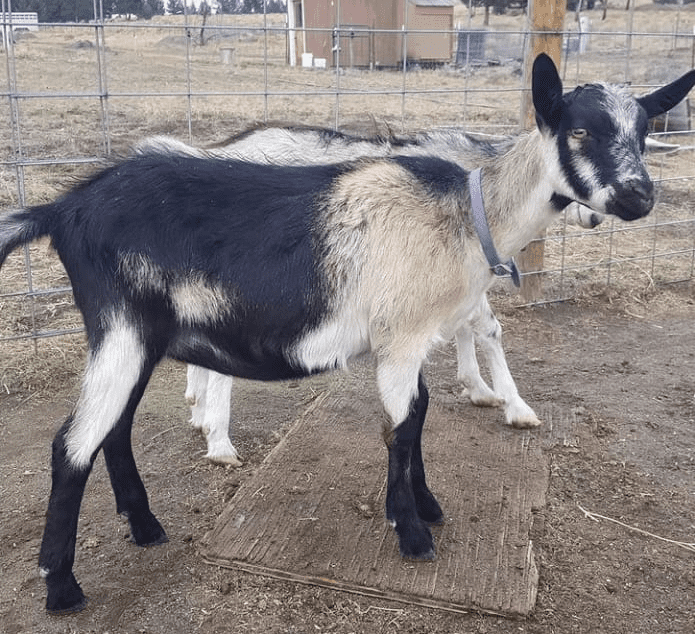Smaller than a cow and needing less feed, the Alpine goat is a good homestead choice for those who have small properties and limited means. They give excellent quality and plentiful milk and the males can be used for meat. The Alpine goat is as close to a dual-purpose dairy goat as you can get.
These ruminant mammals are heavy milkers and will help you achieve a sustainable lifestyle. Alpines, especially the wethers, are also are ideal to raise as pack animals. They are strong, friendly and social. Mini Alpines make great pets. Learn about feeding, milking, breeding and keeping Alpines below.
Alpine Goat History
Alpine goats originated in the French Alps from wild goat herds that lived there. French goat herders domesticated these goats and bred them for greater size and excellent conformation. These goats are also called French goats, French Alpine goats or “Alpine Polychrome” referring to the great variety of colors that this breed exhibits.
Other classifications of this goat came about in the early 1900s, including the American Alpine, the Rock Alpine, the British Alpine, and the Swiss Alpine, also called the Oberhasli.
Despite classifications differences, French Alpine, Swiss Alpine, and Rock Alpine are registrable with the Alpine breed association. The Rock Alpine is American in origin. It’s the result of French and Swiss Alpines being bred together.
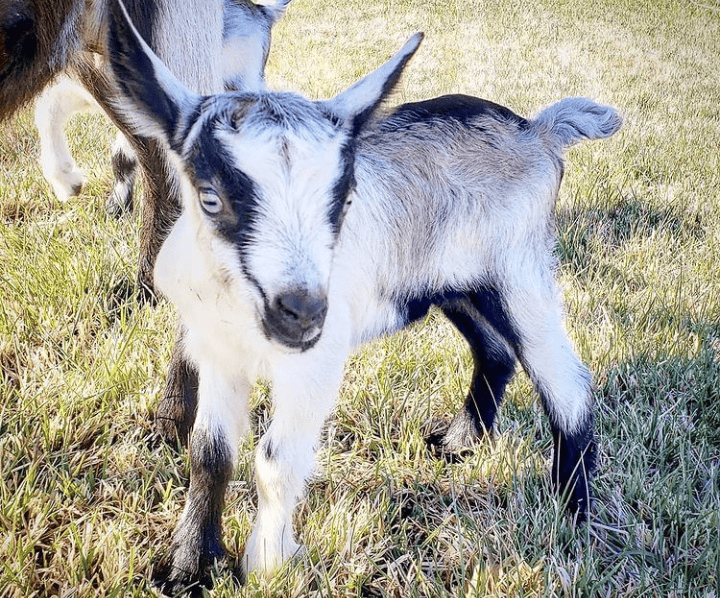
Breed Characteristics and Appearance
Alpine goats are known for being a very pretty breed of goat. Most of them weigh between 130 and 170 pounds and are generally about 30 to 32 inches tall, making them medium to large goats.
When bred with a Nigerian dwarf goat, you can end up with mini Alpine goat crosses. These smaller dairy goats are between 28 and 29 inches tall. They produce almost as much milk as the full size Alpines.
Alpine goats are the only breed with erect ears. This gives their faces a curious and intelligent appearance. Alpine goats have horns. There usually isn’t reason to disbud their goat horns.
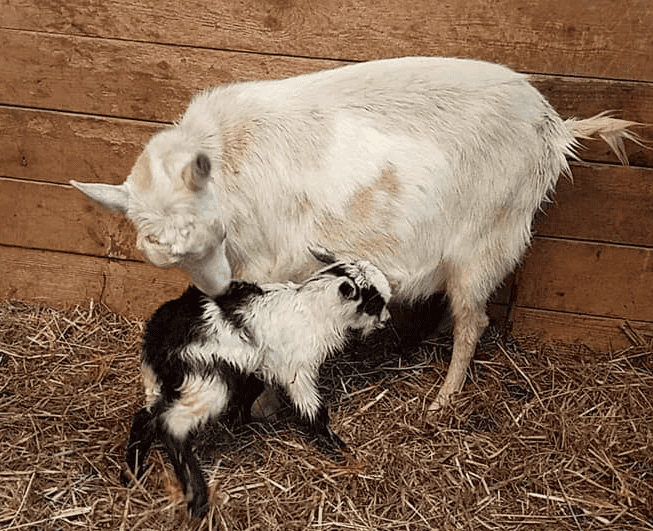
Alpine goats have short to medium length hair, and they come in all sorts of colors and color patterns. You can get an Alpine in various patterns of white, gray, brown, tan, and black. These lovely goats have no set color or pattern, so your tribe of Alpine goats will be unique.
Almost all the buck Alpine goats will have beards. A female Alpine goat may be a bearded goat as well. However, the does will grow beards that are shorter and thinner than the males.
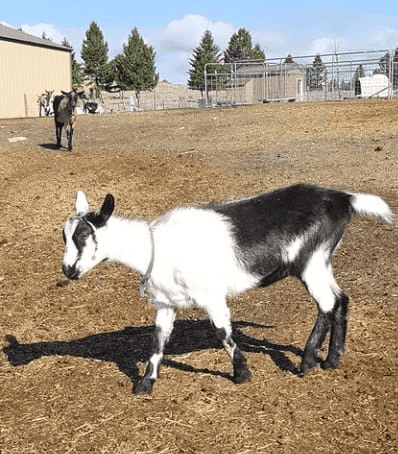
Purpose for Raising Alpine Goats
The main use for Alpine goats is as dairy animals. These are one of the most popular milking breeds. They are heavy, dependable milkers. Homesteaders like these goats because they produce no matter what. Commercial goat milk herds are often comprised solely of Alpine goats because they are so prolific.
Homesteaders often sell their Alpine goat milk to others. You should check into the legalities of this in your area since rules may vary. Other homesteaders use goat milk to make goat milk cheese or goat milk soap to sell.
One great thing about Alpine goats is that, if well-fed, they may go from 1 to 3 years between freshenings. This means that you could have a steady supply of quality milk without having to dry up your dairy goat to prepare for kidding.
Also, with such a long lactation period, you may be able to sell the buck or simply borrow one from a neighbor since you won’t need him for breeding as often.
One nice thing about Alpine goats is that the wethers, castrated males, will yield meat that is comparable in quality and quantity to many meat breeds of goat. They often gain weight just as quickly as only meat breeds of goats. This makes Alpine goats a great choice for a dual-purpose goat for the homestead herd. Another goat with this dual-purpose benefit is the Toggenburg goat.
Some people also use their Alpine goats as pack animals. These animals are smart and strong. This means that they are easy to train and will do well on the trail. These goats learn quickly and have a great sense of direction, leading the pack back to their home if bad weather compromises visibility.
A well-producing Alpine goat can also be used on the homestead to suckle orphaned calves. A gentle, compliant nanny goat could feed one calf for several months.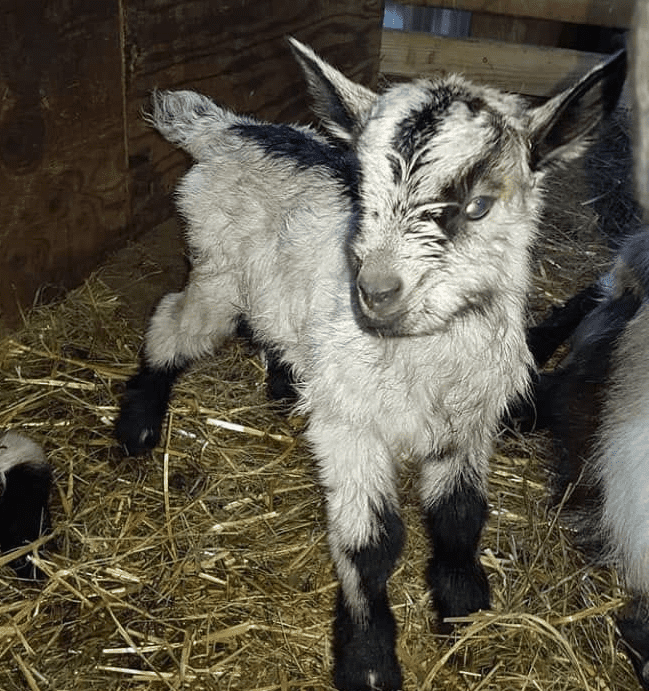
Feeding Alpine Goats
Of course, since Alpine goats are heavy milkers, you must feed them properly. Some Alpine nanny goats will give so much milk that their body condition will suffer if not well-fed. While many people think that goats will eat anything at all, in reality, they need good food to do well.
The Alpine goat will graze pastures. However, they are actually more of browsers than grazers. This means that while they like fresh grass, they also need other things to eat. They love to nibble on brambles, shrubs, and trees. They like to eat the bark of trees, young branch tips, and flowers.
These parts are some of the most nutritious parts of these plants, and goats will go for them every time. They will even eat poison ivy, nettles, thistles, and thorns that your cows and horses will not touch.
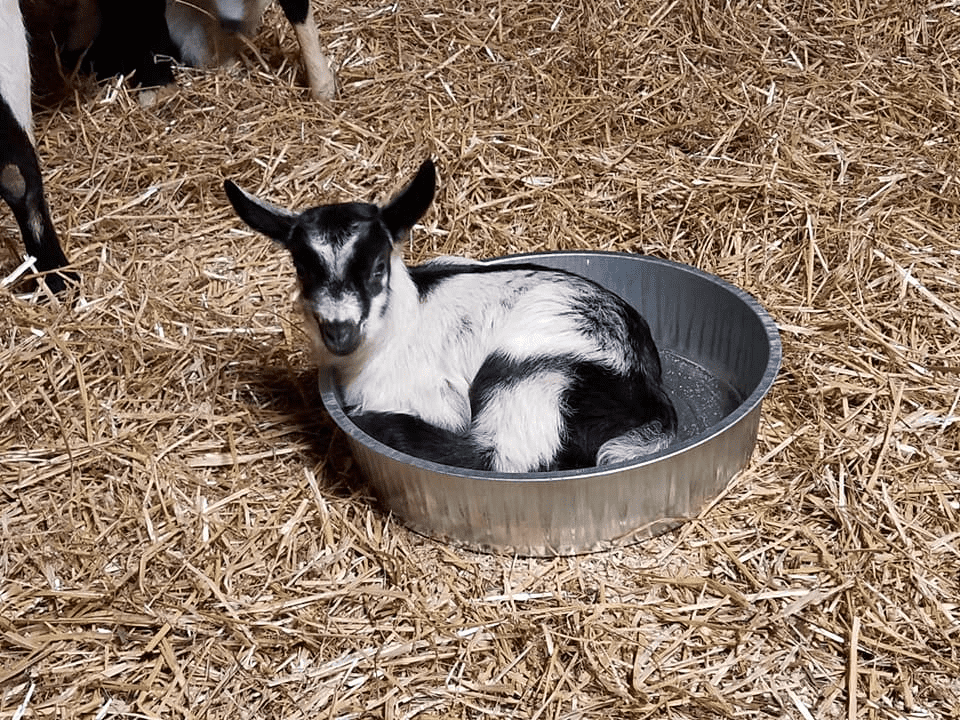
Feeding Goats in Warm Months
Your Alpine goat herd will be happiest in the warm months on weedy, shrubby, partly wooded fields, rather than solely grass based pastures. In moderately temperate climates, one-half acre of field per milking goat should be adequate in the warmer months.
Do not overgraze your fields because this can increase the parasite load in your goats. Rotational grazing is preferred to keep parasites at low levels.
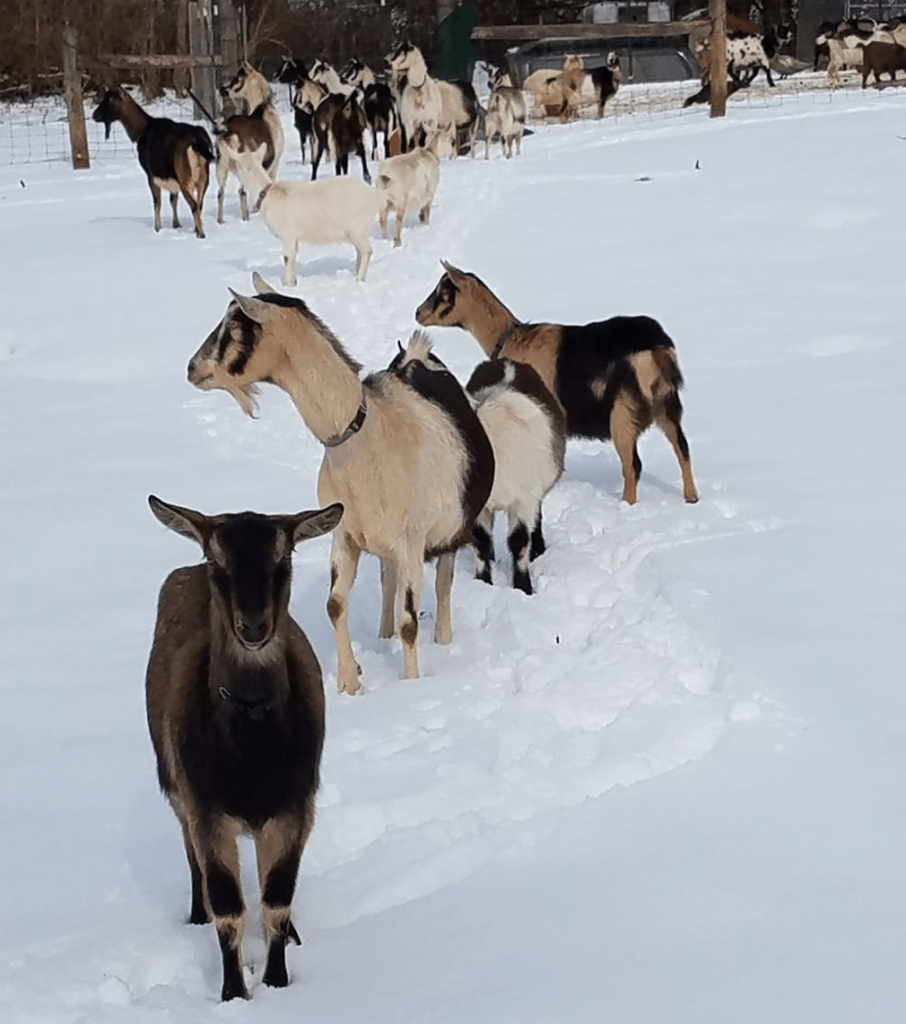
Feeding Goats in Cold Months
In winter, a lactating Alpine goat needs to eat about 5% to 7% of her body weight per day in hay. This means that a 150 pound Alpine doe will eat 7 to 11 pounds of good hay per day. She also will need about a pound of 14% to 16% protein grain mix per day for every 16 cups of milk (one gallon of milk) she produces.
Split this grain feeding up into 2 or 3 feedings given throughout the day. Non-lactating goats may not need much grain at all. You can simply give them a handful as a treat each day.
Alpine goats are very picky eaters and will not eat soiled feed. You should buy hay racks to prevent the goats from wasting hay by stepping on it or laying on it. All goats should have access to salt and a mineral supplement as well. Learn more about what do goats eat.
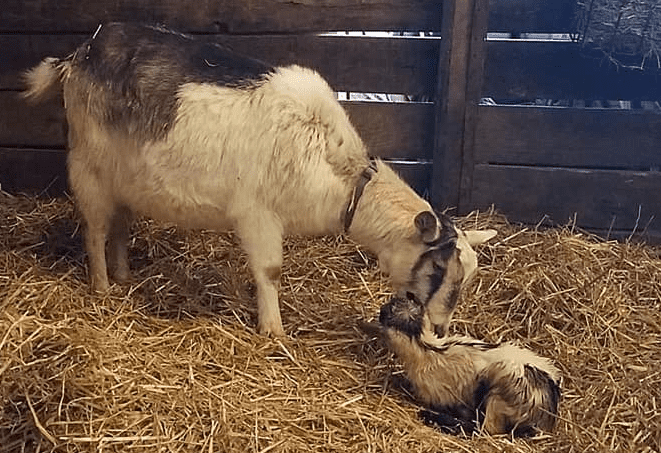
Breeding Alpine Goats
Alpine goats reach sexual maturity at between 4 and 6 months of age. Males tend to be ready to breed earlier than the females. However, just because a female is cycling regularly, it doesn’t mean that she is ready to have a kid.
Good breeders know to wait until the Alpine doe weighs between 75 and 80 pounds to increase the likelihood of a healthy, problem free delivery. Usually, dairy goats reach this size around the age of 8 to 10 months.
Keep intact male and female Alpine goats separate after they are about 4 months old. If housed together, the bucks will try to breed the females before she is big enough to successfully carry a pregnancy, permanently stunting her growth.
Alpine does cycle about every 18 to 21 days, and they are in heat for a few hours to a couple of days. When the doe is bred, she will be pregnant for about 150 days on average. The doe will have 1 – 3 baby Alpine goats on average, with twins being very common. For more about Alpine goat gestation, see how long are goats pregnant. Be sure to learn how to care for the kids and when baby goats can go outside.
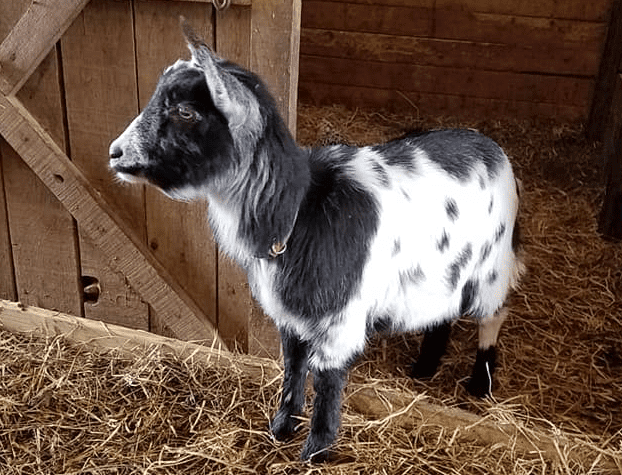
Alpine Does are Seasonal Breeders
Alpine goats, like many dairy breeds, are seasonal breeders. They tend to come into heat more often in the late summer to early fall months. This means that with careful breeding, your kids may be born in early spring, when the pastures are beginning to get green and lush.
Your Alpine goat does will be more productive on pasture. You also won’t have to feed as much expensive hay if you time her breeding carefully.
Alpine goat does will generally give milk for about 10 months, at which time good goat keepers will dry her up for 2 months prior to kidding. This gives the doe’s body a chance to rest and recuperate before she has to raise her kids and provide milk for your homestead. However, some people do allow high producing does to go longer between freshenings.
Milking and Milking Procedures
Alpine goats are very smart and gentle. Training them for milking is relatively easy. Because goats are small, most home milkers build a platform on which the goat stands for milking. Otherwise, stooping low enough for milking is hard on the back.
Before the Alpine doe has her kids, teach her to jump up on the milking stand for a treat of grain. After a few days, the milk of the Alpine goat will come in. The first few days, she gives colostrum that is rich and nutritious for her kids. When her milk is in, she is ready to be milked for your family.
If you don’t want to bottle-feed kids, you can leave the kids on the nanny goat all day and separate them from their mother at night. Next morning, you will milk the goat and turn her out with her babies. The babies get the milk all day.
Twice a day, she can be milked by hand or by machine. Clean her teats well with a damp cloth before milking. If you are using a milking machine, remove the machine when the milk slows to a trickle and her udders are empty. Do not over-milk her, or you may damage her udder.
Milk should be strained immediately to remove any bits of dust, dirt or stray hairs. Many people get in the habit of quickly brushing the goat before milking to remove anything that might fall into the milk bucket. Goat milk should be refrigerated and consumed within three to five days if unpasteurized.
Pasteurizing Goat Milk
To pasteurize goat milk, put the milk in a double boiler or in clean jars in a canner. Heat the milk on the stove to 165 degrees for 15 to 30 seconds. This will kill any bacteria that might be lurking in the milk. Refrigerate pasteurized milk as soon as possible. It will stay good for up to a week in the refrigerator. Label jars with the date so that you can use the oldest milk first.
Goat milk is naturally homogenized, which means that the cream does not separate from the rest of the milk. If you want cream from your goat milk, you will need a cream separator.
At peak lactation, an Alpine goat can give you up to a gallon of milk per day.
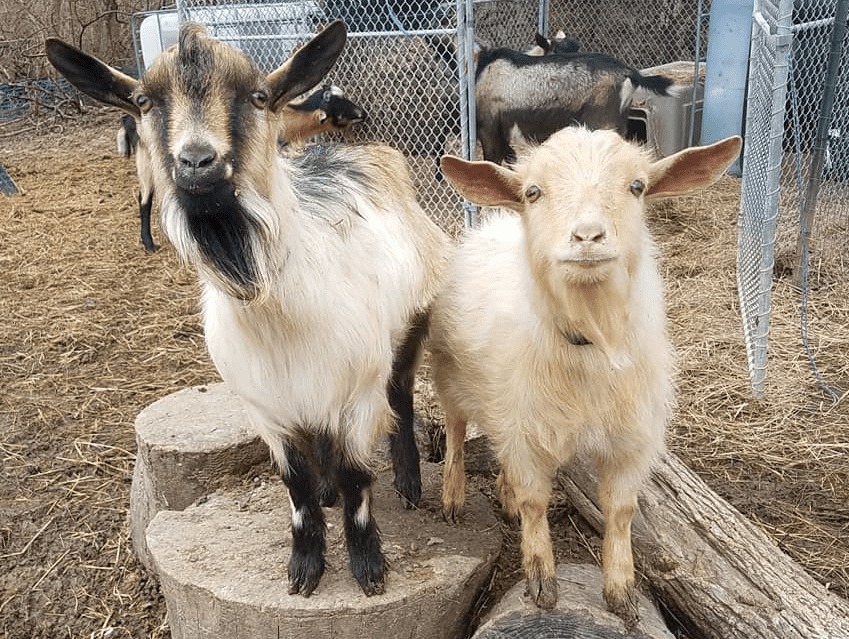
Alpine Goat Meat
Many homesteaders raise Alpine does for milk because they are considered a dairy breed. They will keep a few males for breeding and use the rest of the bucks for meat. They gain weight quickly, making them productive with a decent return on investment.
While they aren’t considered to be the best meat goats for goat meat farming, Alpines are dual purpose in this way. Wethers can also be used as pack animals.
Common Diseases
With dairy goats, there are common diseases to prevent. A sign of mastitis is reduced milk production. Good barn hygiene and being sure to properly prepare and disinfect teats before and after milking can prevent mastitis.
Milk fever is a concern typically caused by a goat diet being low in calcium. Strongyle worms can be prevented by 1) keeping goat feed in feeders and not directly on the ground and 2) by rotating goats between pastures.
Learn how long do goats live for to see how Alpines compare to other dairy goats. On average, an Alpine goat’s lifespan is 8 – 12 years which is comparable to a Toggenburg goat which is also known for its dairy production.
Benefits and Drawbacks of Alpine Goats
Like many goat breeds, Alpine goats are very hardy and are adaptable to a wide variety of climates. They handle heat and cold equally well if they are given appropriate shelter and plenty of clean water. Alpine goats are one of the most prolific dairy goat breeds. They are heavy milkers. Because they are smaller than many other prolific dairy goats, they are ideal for hobby farmers and small homesteads.
Alpine males can be castrated and used for meat, gaining weight at rates that are comparable to meat breeds of goats.
One drawback of the Alpine goat is that they are high-energy goats. Goats in general test fences, and Alpine goats will spend their days looking for holes in your fences and ways to get out. If you want to have Alpine goats, your fences need to be in tip-top condition, preferably with an electric wire along the top to discourage their climbing over the top of the fence.
Consider setting up a goat playground for them with DIY materials and things you may already have. Ramps, tires, and raised platforms will help keep them engaged.
Breed Coloring
More valued for their milk production than their colors, an Alpine’s coloring is defined by what the goat looks like when it is shaved. An Alpine goat color example is cou blanc which means they have whitefront quarters with black and gray hindquarters and head markings.
Cou noir color means the goats have a black front quarters with white hindquarters. Another variation is cou clair which means the goat has lighter colored front quarters (off-white, beige, tan) with black hindquarters.
Goats with the above color variations make the goats appear if they are half one color and half another color.
There are other color varieties as well. Sundgau-colored Alpines are mostly all black with white on their ears, underbody, and lower legs. Pied refers to when the goat coloring is spotted or mottled.

Chamoisee (female) and chamoise (male) is when the entire goat’s body is various shades of brown with some black markings on the face, ears, and legs. – brown or bay characteristic markings are black face, dorsal stripe, feet and legs, and sometimes a martingale running over the withers and down to the chest.
There are also two-tone Chamoisee and broken chamoisee. Variations of these colors combined with white broken patterns have the word “broken” before the color.
You can have a varied trip of goats grazing your property and they can all be Alpines.
Cost for Alpine Goats
How much does an Alpine goat cost depends on many factors. If they are not purebred, adults can cost around $250+. If they are raised as pets more than utility, it can be lower. Much depends on the breed traits, demand, coloring, demand. Breeders may charge more for a registered Alpine.
Raising Alpine Dairy Goats on Your Farm
Alpines are ideal to raise on hobby farms. They are considered among the best farm animals you can raise. They are a domesticated species of goat which are mainly used for their milk. Their milk contains less lactose than the milk from other species of goats.
According to Oregon State Agricultural Extension, over the world, goat milk is the most consumed milk. However, in the United States, it is cow’s milk. In the US, most of the dairy goats are located in the northeast and midwestern states.
The Alpine goats originated from Central/Eastern Europe and were brought to Scandinavia during the medieval period. The first settlers to North America, including the Puritans, brought them with them as a source of food. The Alpine goat was first introduced to the United States by the Swiss in 1820s.
Today, they are used to provide food for a homestead. While you are doing so, you can learn about raising goats for profit. With a decent ROI, they make a good investment. They are hardy and with the proper shelter, are tolerant to many different climates.
Consider raising Alpines with a livestock guardian dog or other livestock guardian animal to help protect them from predators. As herd animals, they will not do well raised alone. If you choose to raise goats, you must raise more than one.
In conclusion, alpine goats are a great option for small farms with the ability to offer milk which you can use to make soap, lotion, cheese and more. They are great dairy source alternative to having cows on your farm.
Other dairy goats to consider raising are Lamancha, Saanan, Nubian (outside the United States they are called Anglo-Nubians), Nigerian Dwarf goats (the smallest of all dairy breeds), and Toggenburg goats (also called Toggs). Learn more about different types of goats, whether you want milk, a sustainable meat source, fibers, or land clearing animals.

